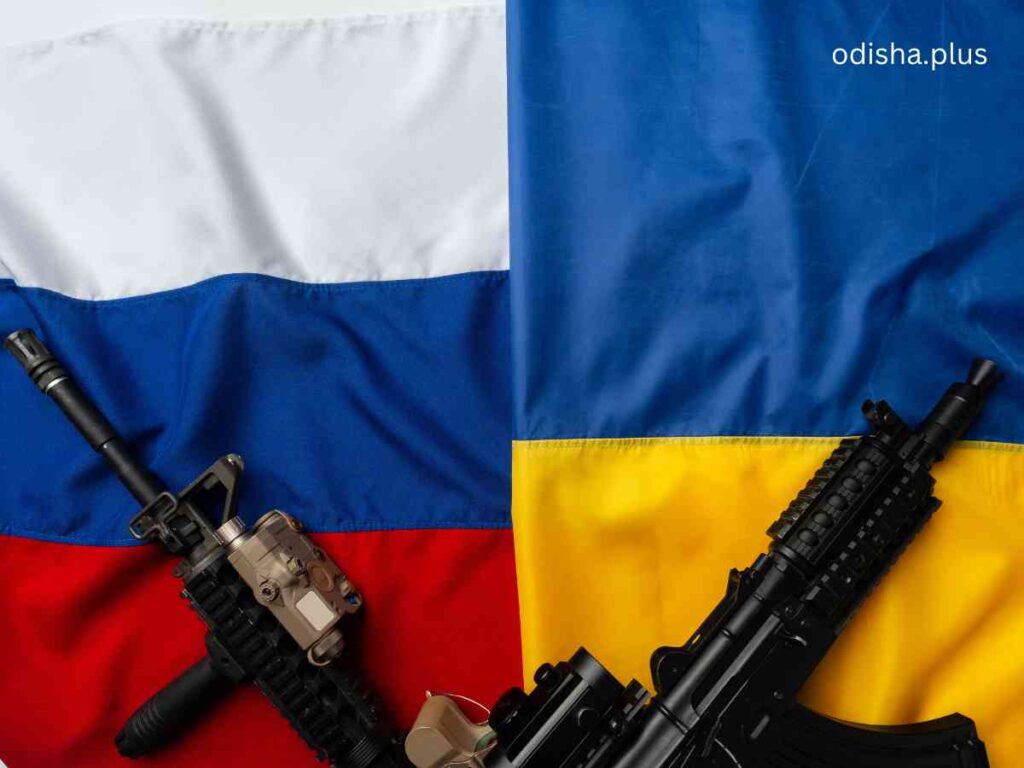During times of conflicts & armed battles, international trade is adversely affected & suffers a range of sanctions heavily disrupting product flow, supply chain, financial returns & ultimately on the foreign exchange reserves
Arnav Patnaik

Trade is critical to economic development and international relations. It allows societies to share and exchange resources necessary for economic growth. Trade flourishes in a favourable diplomatic climate with facilitating policies and limited restrictions on import and export that constitute a significant portion of the GDP of a country.
During times of conflicts and armed battles, international trade is adversely affected and suffers a range of sanctions heavily disrupting product flow, supply chain, financial returns and ultimately on the foreign exchange reserves.
Sanctions and Barriers
When the war broke out in Ukraine in February 2022, the United States of America and the European Union imposed trade sanctions against Russia and its business entities. These sanctions were wide and diverse that ranged from restrictions in exporting of crude oil to using territorial space of certain countries including freezing of assets in native countries and even forcible withdrawal of ownership of a football club.
As many as 16,000 sanctions were imposed on Russia. This is enough to cripple a country’s economy. The USA froze assets worth 300 billion dollars including the US treasury bonds and forex reserves. Russian corporates and businessmen lost their assets they owned in these countries. The Russian Ruble was all set to collapse. But did that happen?
The Russian economy on the contrary grew at a rate of 3.6% in 2023 and almost touched 4% in 2024 despite the sanctions. Russia employed smart strategies to bell itself out of the impending economic crisis caused due to the sanctions.
President Putin allocated 6% of the total GDP as the defense budget knowing well that continuous defense expenditure was crucial for ensuring victory against Ukraine.
Past History
Ukraine and Russia actually shared diplomatic relations a decade ago, when Viktor Fedorovych Yanukovych was the President back in 2013. He abstained from Ukraine’s previous stand of becoming a member of NATO and instead pursued the idea of improving diplomatic relations with Russia. Obviously, this was not taken kindly by the Ukrainian citizens who protested against this move by their President at the time.
After he lost power in 2014, the Russian regime annexed Crimea. If Ukraine became a NATO country, Russia would then share borders with a NATO member, which would enable the US and other EU nations to establish military bases at strategic locations much to the disadvantage of Russia.
In early 2022, Russia pegged its Ruble to gold, and 5,000 Rubles equalled one ounce of pure gold. The plan was to make the Ruble a credible gold substitute at a fixed rate. The gold standard is a financial system, where a nation’s currency has a value linked to gold. This fixed value is used to determine the value of the currency. This ensures inflation is in check and currency value stability.
In Russia, consumer price inflation averaged 7.2% between 2012 and 2022, which was lower than the Eastern European average of 7.7%. The CPI average in 2022 for Russia was a ravaging 13.8%, primarily due to the Ukraine war. Gold-producing nations may have an edge over those that do not produce the precious metal, increasing their reserves.
Gold Reserves
Meanwhile, the World Gold Council has declared the emergence of Russia as the world’s second largest gold producer, with 324.7 metric tonnes in 2023, only behind China. Russia is expected to increase gold production by 4% annually until 2026. World Gold Council also stated that ‘gold’ is the safest investment option during times of conflict. As war causes inflation, people invest in gold because of its limited supply and unlikely dilution in value contrast to currencies. Hence, there was a continuous rise in the price of gold, over the past few years.
Switzerland imported 75 tonnes of Russian gold in 2022, totalling USD 4.87 billion. In 2023, it imported approximately USD 8.22 billion in gold from the United Arab Emirates, which does not produce its own but buys large volumes from Russia and 3.92 billion US Dollars from Uzbekistan, Russia’s neighbour. Billions upon billions of dollars of Russian gold are freely traded at top dollar while exploiting loopholes in all the sanctions.
Russian Oil
Since the EU put restrictions on the imports of Russian natural gas, the Russians had to find other buyers to sell their gas to in order to fund the war, but more importantly prevent the economy from crumbling. As of August 2024, the Chinese and Indian governments accounted for 47% and 37% of the Russian oil exports.
Russia offered their oil at a heavily discounted rate to these two countries, incentivising the purchase of Russian oil. In the first quarter of 2022, when the war was just underway, Russia accounted for 30.5% for EU oil imports (Statista, 2023). This dropped gradually in the succeeding quarters – to a lowest of 12% in the second quarter of 2023. In the first quarter of 2024, it however experienced a rise in the imports of Russian oil into the EU. To compensate for this gradual drop in oil imports, the EU had to look out for alternate suppliers.
In May 2024, surprisingly India was the largest supplier of refined fuel to Europe. Europe’s imports from India for refined fuel went past 360,000 barrels dethroning Saudi Arabia. European Economists termed this as ‘Economic Suicide’. This was because they were buying the same Russian oil but at a premium rate from India. The sanctions backfired on the European Union.
Forex Reserves
Forex reserves are assets that are held by a country’s central bank. It holds reserve currencies like the US Dollar, even other currencies like Euro, Yen, Pound Sterling et cetera. It can be employed to keep the native currency stable, especially during times of economic slumps. It also helps to maintain confidence in the policies for monetary and exchange rate management. Hence, foreign reserves are vital for an economy. From July 2019, the foreign reserves in the Russian nominal GDP started accounting for a greater fraction. Forex reserves accounted for almost 25% of the nominal GDP and rose to almost 30% in July 2021, a 10 year high.
After July 2021, the forex reserves started depleting. In July 2022, months after the war started, forex reserves accounted for almost 21% of the Russian GDP. In September 2022, Russian forex reserves stood at USD 541 Billion, its lowest since 2015, when they held USD 356 billion.
This could be attributed to selling off currencies like USD, Pound sterling, Yuan and Yen, amongst others to stabilize the Ruble, by increasing demand for the currency. The freezing of assets by US and other European Union nations aggravated this depletion. But ever since October 2023, it has seen a gradual incline. As of October 4, 2024, Russia had approximately 630 billion US dollars in Foreign Exchange reserves.
At the start of 2022, prior to the war in Ukraine, the country’s foreign exchange reserves were valued at USD 630.5 billion. The Russians have successfully revamped their foreign reserves back to pre-war levels, establishing confidence and stability.
Semi-conductor Masterstroke
Another master plan employed that has often been undermined by most economists and world citizens is the purchase of sophisticated semi-conductors. Russian factories operate at 65 nanometre chip technology. These chips have various military applications, which include radar systems, encryption and power management. But the major issue was that this tech is very primitive and outdated. It is estimated that this tech employed by Russia is 15 years behind that employed by the USA.
The Americans felt they could corner the Russians if they manage to cut off Russia from accessing the newest chips, something they could not produce. However, the story took a different turn. First, Russia managed to do so, by purchasing ordinary computer chips and components found in consumer products, which were often produced in the US, and that were subject to lesser export controls. Second, Russia hired a network of third-party traders, who had access components used in tanks, drones and missiles. Finally, Russia took advantage of the changing geo-political scenario.
The gradual shift from a unipolar world, where the US was the sole superpower to a multi-polar world with multiple players gave Russia the transactional leverage it needed. Countries like India, China, Turkey and UAE not only continued trade relations with Russia but further strengthened it.
New Sheriff
The BRICS, the intergovernmental organization between Brazil, Russia, India, China and South Africa played and will continue to play a major part in providing support to the Russian economy. In the history of modern world economy this could be a momentous phase. Previously, the world economy has been dominated by the US Dollar, as most countries including the biggest economies, deal in US Dollar for international transactions. Dollar, the existing principal currency of the world, accounts for more than 80% of the global trade. This also contributed to an increase in the sale of US Treasury bonds as their currency was more demanded. Hence, a safe bet for governments.
BRICS have increasingly dealt with the native currencies of members and partners, especially China’s ‘Reminbi’ international transactions within the BRICS community (Council on Foreign Affairs). The BRICS countries were widely expected to continue their discussions about developing a possibly gold-backed currency, known as the ‘Unit,’ as an alternative to the US dollar.
This policy could hold crucial importance as the BRICS, today holds vital economic significance in the world economy. The broadened group has an aggregate population of approximately 3.5 billion people, or 45% of the world’s total.
Members’ economies total more than $28.5 trillion, accounting for roughly 28% of the global economy, the expanded group forms 33% of the world economy. The BRICS partners like Iran, Saudi Arabia and UAE, produce approximately 44% of the world’s crude oil. In 2014, the BRICS countries established the New Development Bank, in Shanghai, to lend money to improve infrastructure. There was a new proposal of a ‘Stablecoin’ that will be used for international transitions amongst the members and partners of BRICS, using block chains challenging the SWIFT.
This would ensure the members’ and partners’ currency is stable and adversely impacts the USA and the West and decreases their reliance on USD and Euros. The BRICS started as a model economic union of the members, and as it expanded has also become an avenue for countries to hold diplomatic dialogue, the most recent case being the military disengagement of members China and India. And for a grand design for the future, it also plans to hold trade relations and talks within the community for commodities like food grains and crude oil, ideally at a discounted rate. All this would ensure diplomatic and economic harmony within BRICS.
A major incident during the 2024 US presidential elections was the statement by President Donald Trump, to ensure that countries avoiding the US Dollar would be subject to tumultuous tariffs by the US, which could bring an economic slouch.
On the flipside, this would incentivise countries to move away from its Western allies and attempt to join BRICS, as no nation would want to be bullied into becoming a puppet of the West, the US in particular. Hence, it would further deepen the ‘De-Dollarization’ process.
(Views expressed are personal)
#russia #ukraine #russia-ukraine-war #intenational #international-trade




























Excellently penned.